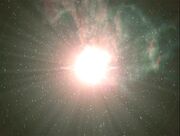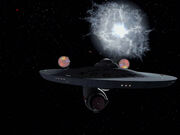Archer4real (talk | contribs) No edit summary |
No edit summary Tag: sourceedit |
||
| (7 intermediate revisions by 5 users not shown) | |||
| Line 1: | Line 1: | ||
[[File:Supernova.jpg|thumb|A supernova explosion]] |
[[File:Supernova.jpg|thumb|A supernova explosion]] |
||
[[File:Beta Niobe nova remastered.jpg|thumb|[[Beta Niobe]] goes nova in [[2269]]]] |
[[File:Beta Niobe nova remastered.jpg|thumb|[[Beta Niobe]] goes nova in [[2269]]]] |
||
| − | + | {{disambiguation|the beverage|Supernova (beverage)}} |
|
| ⚫ | A '''supernova''' |
||
| ⚫ | A '''supernova''' or '''nova''' was a massive explosion that typically occurred upon the death of an old [[star]]. When a massive star ran out of nuclear fuel, the star had no counteractive force against its own [[gravity]] and collapses. The resulting [[shock wave]] blew the outer layers of the star into [[space]], possibly leaving a core that becomes either a [[neutron star]] or a [[black hole]], depending on the remaining mass. A different kind of supernova occurred (more rarely in our [[Milky Way Galaxy]]) when a [[white dwarf]] star in a tight [[Multiple star system|binary system]] swallowed material from her companion, eventually becoming too massive and collapsing. The increased mass would cause fusion to reignite violently, resulting in a Type Ia supernova. |
||
| ⚫ | |||
| + | == History == |
||
| ⚫ | When stars |
||
| ⚫ | |||
| + | |||
| ⚫ | When stars exploded, they emit an electrical magnetic pulse. This pulse can cause electro-magnetic devices such as [[computer|computers]] to fail. An event of this kind took place in [[2364]] when a star in the [[Beta Magellan system]] supernovaed resulting in main computer failure on [[Bynaus]]. ({{TNG|11001001}}) |
||
A supernova which occurred [[Half a million years ago|600,000 years ago]], during the [[Age of Makto]], was responsible for the fall of the [[Tkon Empire]]. ({{TNG|The Last Outpost}}) |
A supernova which occurred [[Half a million years ago|600,000 years ago]], during the [[Age of Makto]], was responsible for the fall of the [[Tkon Empire]]. ({{TNG|The Last Outpost}}) |
||
| + | |||
| + | The [[Fabrina solar system]] went nova some ten thousand years before the [[23rd century]]. |
||
In [[July]] [[2151]], [[Enterprise (NX-01)|''Enterprise'']] came within three light years of a [[J'ral class]] supernova remnant, but did not break course to study it. ({{ENT|Civilization}}) |
In [[July]] [[2151]], [[Enterprise (NX-01)|''Enterprise'']] came within three light years of a [[J'ral class]] supernova remnant, but did not break course to study it. ({{ENT|Civilization}}) |
||
In [[2268]], the crew of the {{USS|Enterprise|NCC-1701}} observed the supernova [[Beta Niobe]] and the destruction of planet [[Sarpeidon]]. A few weeks earlier, she had already witnessed the supernova [[Minara]]. ({{TOS|The Empath|All Our Yesterdays}}) |
In [[2268]], the crew of the {{USS|Enterprise|NCC-1701}} observed the supernova [[Beta Niobe]] and the destruction of planet [[Sarpeidon]]. A few weeks earlier, she had already witnessed the supernova [[Minara]]. ({{TOS|The Empath|All Our Yesterdays}}) |
||
| + | |||
| + | A [[Operation Retrieve star chart locations|chart]] in the command briefing for [[Operation Retrieve]] featured [[Frazee's Nova]] and [[Winter's Nova]]. ({{film|6}}) |
||
In [[2366]], the star [[Beta Stromgren]] exploded as a supernova. The last stages of the star's life were observed by the {{USS|Enterprise|NCC-1701-D|-D}} while taking first contact with the creature [[Gomtuu]]. ({{TNG|Tin Man}}) |
In [[2366]], the star [[Beta Stromgren]] exploded as a supernova. The last stages of the star's life were observed by the {{USS|Enterprise|NCC-1701-D|-D}} while taking first contact with the creature [[Gomtuu]]. ({{TNG|Tin Man}}) |
||
| Line 23: | Line 29: | ||
The crew of ''Voyager'', acting on information provided by the female Q, used the explosion of one of these supernovae to enter the Continuum themselves, in order to rescue [[Q]] and Captain [[Kathryn Janeway|Janeway]]. ({{VOY|The Q and the Grey}}) |
The crew of ''Voyager'', acting on information provided by the female Q, used the explosion of one of these supernovae to enter the Continuum themselves, in order to rescue [[Q]] and Captain [[Kathryn Janeway|Janeway]]. ({{VOY|The Q and the Grey}}) |
||
| − | |||
| ⚫ | |||
Several weeks later, in the [[Alpha Quadrant]], the [[Julian Bashir (Changeling)|Changeling]] posing as [[Doctor]] [[Julian Bashir]] attempted to trigger a supernova in the [[Bajoran sun]] using [[trilithium]], [[tekasite]] and [[protomatter]]. The Founder was stopped by [[Kira Nerys]], [[Jadzia Dax]] and the crew of the {{USS|Defiant|2370}}. ({{DS9|By Inferno's Light}}) |
Several weeks later, in the [[Alpha Quadrant]], the [[Julian Bashir (Changeling)|Changeling]] posing as [[Doctor]] [[Julian Bashir]] attempted to trigger a supernova in the [[Bajoran sun]] using [[trilithium]], [[tekasite]] and [[protomatter]]. The Founder was stopped by [[Kira Nerys]], [[Jadzia Dax]] and the crew of the {{USS|Defiant|2370}}. ({{DS9|By Inferno's Light}}) |
||
| Line 33: | Line 37: | ||
In [[2387]], a [[Supernova of 2387|supernova]] threatened the [[Milky Way Galaxy|galaxy]]. [[Ambassador]] [[Spock]] stopped the supernova by using [[red matter]] to create a [[black hole]], which consumed the supernova. Before he could, however, the supernova destroyed [[Romulus]]. ({{film|11}}) |
In [[2387]], a [[Supernova of 2387|supernova]] threatened the [[Milky Way Galaxy|galaxy]]. [[Ambassador]] [[Spock]] stopped the supernova by using [[red matter]] to create a [[black hole]], which consumed the supernova. Before he could, however, the supernova destroyed [[Romulus]]. ({{film|11}}) |
||
| − | |||
| ⚫ | |||
==Supernova classes== |
==Supernova classes== |
||
* [[J'ral class]] |
* [[J'ral class]] |
||
| − | == |
+ | == Appendices == |
| + | === Background information === |
||
| + | In the {{st-minutiae|academy/literature329/tmp.txt|shooting script}} of ''[[Star Trek: The Motion Picture]]'', the film would have begun in deep [[space]]. The camera would focus in on a white star in a [[star system]] "''...suddenly changing, brightening, flaring unbelieavable intensity: supernova.''" Pausing briefly as witness to this celestial event, the camera would move on searching for ''[[V'ger]]''. |
||
| + | |||
| ⚫ | |||
| + | |||
| ⚫ | In ''[[Star Trek: Countdown]]'', the official comic book prequel to ''Star Trek'', the star which went supernova and destroyed Romulus was called the Hobus star. It was explained that the Hobus supernova was unlike any previously seen: as the supernova grew, it converted [[mass]] into [[energy]], which increased its power and allowed it to expand. As a result, its threat reached beyond the Hobus system and potentially the entire galaxy. |
||
| + | |||
| + | === External link === |
||
* {{wikipedia}} |
* {{wikipedia}} |
||
| Line 45: | Line 55: | ||
[[pl:Supernowa]] |
[[pl:Supernowa]] |
||
[[Category:Astronomical objects]] |
[[Category:Astronomical objects]] |
||
| − | [[Category:Memory Alpha articles related to Star Trek (film)]] |
||
Revision as of 13:09, 28 March 2015

A supernova explosion

Beta Niobe goes nova in 2269
A supernova or nova was a massive explosion that typically occurred upon the death of an old star. When a massive star ran out of nuclear fuel, the star had no counteractive force against its own gravity and collapses. The resulting shock wave blew the outer layers of the star into space, possibly leaving a core that becomes either a neutron star or a black hole, depending on the remaining mass. A different kind of supernova occurred (more rarely in our Milky Way Galaxy) when a white dwarf star in a tight binary system swallowed material from her companion, eventually becoming too massive and collapsing. The increased mass would cause fusion to reignite violently, resulting in a Type Ia supernova.
History
In the negative universe, a supernova was a dead star coming to life. (TAS: "The Counter-Clock Incident")
When stars exploded, they emit an electrical magnetic pulse. This pulse can cause electro-magnetic devices such as computers to fail. An event of this kind took place in 2364 when a star in the Beta Magellan system supernovaed resulting in main computer failure on Bynaus. (TNG: "11001001")
A supernova which occurred 600,000 years ago, during the Age of Makto, was responsible for the fall of the Tkon Empire. (TNG: "The Last Outpost")
The Fabrina solar system went nova some ten thousand years before the 23rd century.
In July 2151, Enterprise came within three light years of a J'ral class supernova remnant, but did not break course to study it. (ENT: "Civilization")
In 2268, the crew of the USS Enterprise observed the supernova Beta Niobe and the destruction of planet Sarpeidon. A few weeks earlier, she had already witnessed the supernova Minara. (TOS: "The Empath", "All Our Yesterdays")
A chart in the command briefing for Operation Retrieve featured Frazee's Nova and Winter's Nova. (Star Trek VI: The Undiscovered Country)
In 2366, the star Beta Stromgren exploded as a supernova. The last stages of the star's life were observed by the USS Enterprise-D while taking first contact with the creature Gomtuu. (TNG: "Tin Man")
Supernovae, however, generally occur only approximately twice per century in the Milky Way Galaxy. As of the 24th century, only three Starfleet vessels ever witnessed supernovae firsthand. The record for the closest observation was less than 10 billion kilometers and was set by the USS Voyager in 2373. (VOY: "The Q and the Grey")
In 2373, a number of supernovae occurred within a small region of the Delta Quadrant, as a result of the Q Civil War. These supernovae were actually the result of spatial disruptions within the Q Continuum.
It was explained to Chakotay, by a female Q, that "each time a star implodes, a negative density false vacuum is created, which actually sucks the surrounding matter into the Continuum."
The crew of Voyager, acting on information provided by the female Q, used the explosion of one of these supernovae to enter the Continuum themselves, in order to rescue Q and Captain Janeway. (VOY: "The Q and the Grey")
Several weeks later, in the Alpha Quadrant, the Changeling posing as Doctor Julian Bashir attempted to trigger a supernova in the Bajoran sun using trilithium, tekasite and protomatter. The Founder was stopped by Kira Nerys, Jadzia Dax and the crew of the USS Defiant. (DS9: "By Inferno's Light")
When Janeway requested arithrazine from The Doctor in 2374, he asked her if she was planning to "stroll through a supernova." (VOY: "The Omega Directive")
In 2375, Janeway used studying a supernova remnant as an excuse for entering a restricted part of Devore space.(VOY: "Counterpoint")
In 2387, a supernova threatened the galaxy. Ambassador Spock stopped the supernova by using red matter to create a black hole, which consumed the supernova. Before he could, however, the supernova destroyed Romulus. (Star Trek)
Supernova classes
Appendices
Background information
In the shooting script of Star Trek: The Motion Picture, the film would have begun in deep space. The camera would focus in on a white star in a star system "...suddenly changing, brightening, flaring unbelieavable intensity: supernova." Pausing briefly as witness to this celestial event, the camera would move on searching for V'ger.
It was never clarified if the spatial disruptions in the Q Continuum were created deliberately or merely side-effects of various Q weaponry, but only that the Q civil war, and Q's actions, were having galactic consequences.
In Star Trek: Countdown, the official comic book prequel to Star Trek, the star which went supernova and destroyed Romulus was called the Hobus star. It was explained that the Hobus supernova was unlike any previously seen: as the supernova grew, it converted mass into energy, which increased its power and allowed it to expand. As a result, its threat reached beyond the Hobus system and potentially the entire galaxy.
